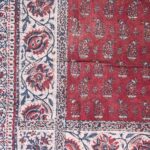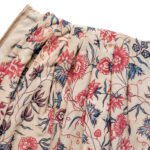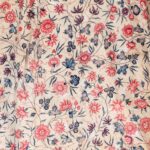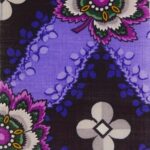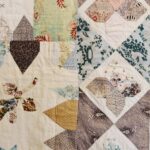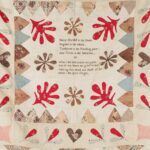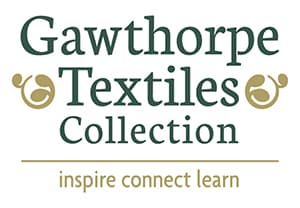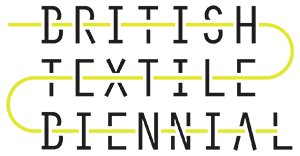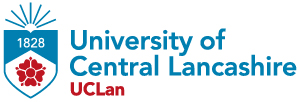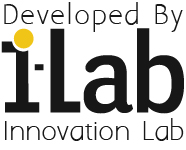A full-length petticoat made from brightly coloured printed cotton in vibrant Turkey Red, green and yellow. The lower part of the petticoat is quilted in deep wavy bands decorated with narrow braid and each band is filled with down feathers. As well as being a lightweight but incredibly warm garment these down petticoats also had […]
View moreThis commercial sample still has an unknown manufacturer’s label attached to the top edge, along with three swatches showing the same design on different coloured backgrounds. The complex and stylised floral pattern borrows heavily from Indian chintz designs but uses a colour palette more contemporary to the late 19th century; incorporating a lot more green […]
View moreA number of print methods are evident on this piece, which was likely created in India or Iran for the European market. The central square of the front is block printed with a deep red background and boteh motifs, while the surrounding intricate floral border is created with resist dyeing and either block printing or […]
View moreThe front of this cloth features a heavily patterned floral central square surrounded by several narrower borders and an intricate edging of ‘Paisley’ boteh or buta motifs. These heavily stylised teardrop or pinecone shapes originated in Persian design but also became popular in India, particularly in Kashmiri shawls. The English term for the pattern comes […]
View moreFashion Historian Amber Butchart curates an exhibition exploring movement, migration and making using pieces found in the Gawthorpe Textiles Collection.
View moreA skirt or petticoat made from smooth cotton calico and lined throughout with a soft and coarsely woven cotton. The overall floral pattern is hand block printed and dyed using madder and indigo dyes with simple yet effective use of colour shading and layering to give a variety of colour tones using just a few […]
View moreThis sample is one of a set of over 90 print samples attributed to the Robert Hindle & Co Print Works in Sabden, Lancashire. The vibrant colours of the samples are a perfect example of the impact that aniline dyes had on the dyeing and printing industries. The first aniline dye was mauveine or ‘Perkin’s […]
View moreThis sample is one of a set of over 90 print samples attributed to the Robert Hindle & Co Print Works in Sabden, Lancashire. The vibrant colours of the samples are a perfect example of the impact that aniline dyes had on the dyeing and printing industries. The first aniline dye was mauveine or ‘Perkin’s […]
View moreThese samples are from a set of 90 print samples attributed to the Robert Hindle & Co Print Works in Sabden, Lancashire. The vibrant colours of the samples are a perfect example of the impact that aniline dyes had on the dyeing and printing industries. The first aniline dye was mauveine or ‘Perkin’s Purple’, discovered […]
View morePatchwork and appliqué cot coverlet made by Nancy Horsfall in 1834. White linen ground with appliqué motifs including stylised leaves or branches, six pointed stars and a four leaf clover like design in the very centre. Around this is a dog tooth or Vandyke border, then a border of pieced patchwork triangles surrounding lozenges arranged […]
View morePatchwork and appliqué coverlet made from printed cottons by Nancy Horsfall for her wedding in 1833. The design uses a typical early 19th century frame layout with a central section of finer, smaller scale piecing and appliqué that would have been the most visible part on the flat top of the bed. The edges are […]
View more

